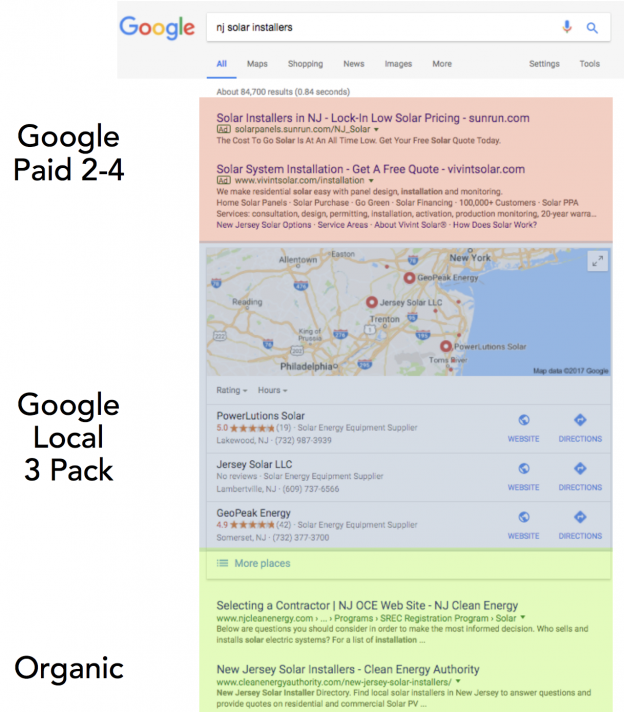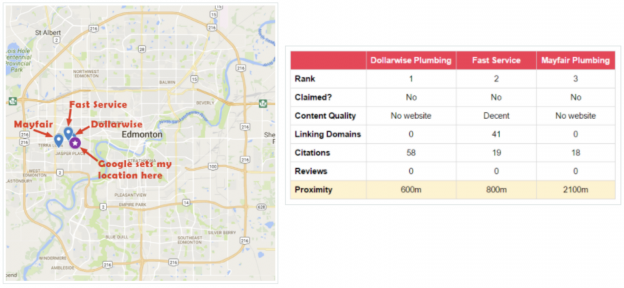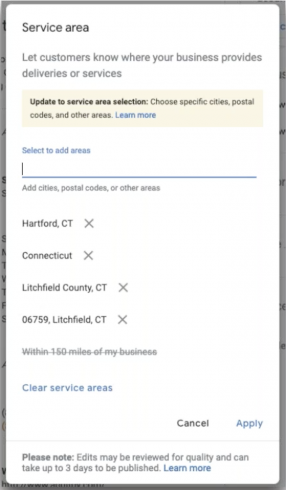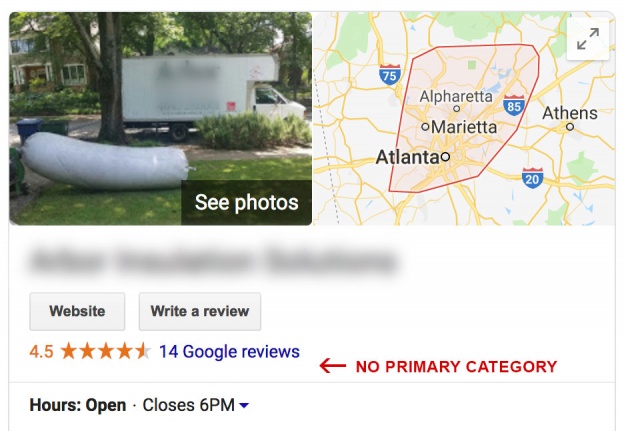
If you’re a contractor in the HVAC, home performance, or solar industry, you likely understand the frustrations of trying to beat out local competition on Google. Thanks to Google’s proximity bias, it can be tough to rank as a contractor even in cities that are next door to the one your office is located in.
That said, there are changes on the horizon designed especially for service area businesses — ones which we hope will help businesses like yours rank better in local searches for the services you offer. (We discussed these changes in depth in our most recent webinar.) Learn more about how Google is handling the proximity bias for service area oriented businesses — and what you can do to boost your company’s local search rankings.
The Local Search & Proximity Challenge: A Review
Service area oriented businesses rely heavily on local search rankings to capture leads. A typical SERP for a local search like “nj solar installers” looks something like this:

The top two to four results will be paid ads, followed by the Local 3-Pack and then organic results. If Local Services Ads are in your area, those would appear above paid ads.
The top two to four results will be paid ads, followed by the Local 3-Pack and then organic results. If Local Services Ads are in your area, those would appear above paid ads.
A number of ranking factors determine what shows up in that Local 3-Pack; but as we know from Moz’s 2018 Local Search Ranking Factors Survey, Google My Business signals — including proximity — make up about 25% of those ranking factors. This means that Google prioritizes connecting users to the businesses that are closest to them.
This is great news if you’re a coffee shop that’s trying to bring in nearby customers who happen to be looking for a cup of joe; but if you’re an HVAC, home performance, or solar contractor, proximity is less important. A homeowner who is searching for furnace repair service, for example, cares less about which HVAC contractor has an office located right in their city and more about which HVAC contractor offers the best service in their area.
Take this study of plumbing business rankings in Edmonton, Canada, for example:

A search for a plumbing specialist just outside of Edmonton pulled these three plumbing contractors into the Local 3-Pack.
A search for a plumbing specialist just outside of Edmonton pulled these three plumbing contractors into the Local 3-Pack.
The top three plumbing contractors in the Local Pack all have relatively poor SEO — none have claimed their business on Google. two have no website, and none have any reviews. However, their close proximity to the searcher ranks them in the Local Pack. Meanwhile, other plumbing contractors with strong reviews, great citations, and relevant site content — contractors whom local customers may ultimately prefer to hire — are not featured in the Local Pack.
The bottom line is this: Proximity is not the number-one factor that your customers weigh when deciding whether or not to do business with a service area business; yet it remains the number-one ranking factor for Google’s Local Pack. This presents a unique challenge to service area businesses who wish to rank anywhere in their service area outside of where their physical location is.
What’s Changing for Service Area Businesses
The good news? We are seeing some changes which seem to signal that Google recognizes a difference between “coffee shop businesses” and businesses with a service area. Recently, Google began allowing businesses to add more customized service areas to their GMB listings. Instead of creating your service area based on a distance radius, you can enter specific cities, counties, states, and zip codes.

The new service area feature in Google My Business lets you specify your service area with cities, counties, states, and zip codes. You can no longer use a distance radius to define your service area.
The new service area feature in Google My Business lets you specify your service area with cities, counties, states, and zip codes. You can no longer use a distance radius to define your service area.
However, this service area feature should not necessarily replace your physical address on GMB. According to Google, if you serve customers at your business address, you should keep your address and add a service area to it. If, on the other hand, you do not serve customers at your business address, Google recommends leaving the address field blank.
Our Recommendations
If you do not serve customers at your business address, we advise following Google’s recommendations on 1) updating your service area and 2) clearing your address. However, there are some important nuances to be aware of as you navigate this process. Here is our take on Google’s recommendations.
Update Your Service Area
Head to the service area section of GMB to update your service area. (You likely set your service area previously using a radius.) From the service area section, you can set your service area using specific cities, counties, or zip codes. We recommend using the fastest and most direct path for this — which may include a combination of cities, counties, and zip codes. As you refine your service area, beware of strange boundaries which may make your service area look odd.
Clear Your Address If It Has Not Been Cleared
Google has been gradually clearing the addresses of service area businesses that do not have a storefront. If this has happened to you, do not put the address back in. If this has not yet happened to you, go ahead and clear the address on your own.
Watch for the ‘Primary Category’ Bug
After you’ve cleared your address and updated your service area, you may notice a problem in your Knowledge Panel where your primary category is missing. The problem looks something like this:

When you clear your address and update your service area in GMB, you may notice your primary category disappear in the Knowledge Panel due to a glitch.
When you clear your address and update your service area in GMB, you may notice your primary category disappear in the Knowledge Panel due to a glitch.
The good news is that this problem seems to be confined only to the Knowledge Panel, which comes up when a user performs a brand search of your company’s name (in which case, the user likely already knows what you do). The primary category still shows up in Maps and in the Local Pack.
That said, clearly we are undergoing a transitional phase with this new service area feature. We are in touch with someone who is looking into this issue with Google. While the kinks get worked out, we still recommend clearing your address and updating your service area. Google does not necessarily roll out all of its platform changes at once; what some businesses may have experienced may not have occurred for others, yet.
Continue Optimizing for Local
Don’t forget to continue optimizing your website for local. This includes featuring location tagged testimonials on your website, adding location tagged case studies, and creating city pages to draw attention to the particular areas that you serve. (We cover these topics more comprehensively in our previous webinar about overcoming the proximity bias.)
Get Ahead of the Game
Remember — Google still weighs proximity heavily in the realm of local search, but hope is on the horizon. We’re hoping that this move to a more accurate service area is a signal that Google will soon make changes to reduce or eliminate the proximity bias for service area businesses. While Google (hopefully) continues to make changes to better serve service area businesses, make sure you’re getting ahead of the game by updating your GMB profile and optimizing your website.